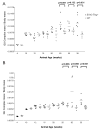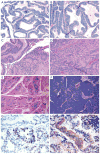Prostate carcinoma in transgenic Lewis rats - a tumor model for evaluation of immunological treatments
- PMID: 24324949
- PMCID: PMC3855422
- DOI: 10.3978/j.issn.2304-3865.2012.11.06
Prostate carcinoma in transgenic Lewis rats - a tumor model for evaluation of immunological treatments
Abstract
Transgenic rodent models of prostate cancer have served as valuable preclinical models to evaluate novel treatments and understand malignant disease progression. In particular, a transgenic rat autochthonous model of prostate cancer using the SV40 large T antigen expressed under a prostate-specific probasin promoter was previously developed as a model of androgen-dependent prostate cancer (TRAP). In the current report, we backcrossed this strain to the Lewis strain, an inbred rat strain better characterized for immunological analyses. We demonstrate that Lewis transgenic rats (Lew-TRAP) developed prostate adenocarcinomas with 100% penetrance by 25 weeks of age. Tumors were predominantly androgen-dependent, as castration prevented tumor growth in the majority of animals. Finally, we demonstrate that Lew-TRAP rats could be immunized with a DNA vaccine encoding a human prostate tumor antigen (prostatic acid phosphatase) with the development of Lewis strain-specific T-cell responses. We propose that this Lew-TRAP strain, and prostate tumor cell lines derived from this strain, can be used as a future prostate cancer immunotherapy model.
Keywords: Lewis rat; prostate cancer; transgenic; vaccine.
Conflict of interest statement
Figures




Similar articles
-
Safety and immunological efficacy of a prostate cancer plasmid DNA vaccine encoding prostatic acid phosphatase (PAP).Vaccine. 2006 Jan 16;24(3):293-303. doi: 10.1016/j.vaccine.2005.07.074. Epub 2005 Aug 9. Vaccine. 2006. PMID: 16115700
-
Development, progression, and androgen-dependence of prostate tumors in probasin-large T antigen transgenic mice: a model for prostate cancer.Lab Invest. 1998 Mar;78(3):319-33. Lab Invest. 1998. Corrected and republished in: Lab Invest. 1998 Jun;78(6):i-xv. PMID: 9520945 Corrected and republished.
-
Development, progression, and androgen-dependence of prostate tumors in probasin-large T antigen transgenic mice: a model for prostate cancer.Lab Invest. 1998 Jun;78(6):i-xv. Lab Invest. 1998. PMID: 9645768
-
The C3(1)/SV40 T-antigen transgenic mouse model of mammary cancer: ductal epithelial cell targeting with multistage progression to carcinoma.Oncogene. 2000 Feb 21;19(8):1020-7. doi: 10.1038/sj.onc.1203280. Oncogene. 2000. PMID: 10713685 Review.
-
Human prostate cancer progression models and therapeutic intervention.Hinyokika Kiyo. 1997 Nov;43(11):815-20. Hinyokika Kiyo. 1997. PMID: 9436028 Review.
Cited by
-
Development of animal models underlining mechanistic connections between prostate inflammation and cancer.World J Clin Oncol. 2013 Feb 10;4(1):4-13. doi: 10.5306/wjco.v4.i1.4. World J Clin Oncol. 2013. PMID: 23539141 Free PMC article.
References
-
- Sim HG, Cheng CW. Changing demography of prostate cancer in Asia. Eur J Cancer. 2005;41:834–45. - PubMed
-
- Hurwitz AA, Foster BA, Kwon ED, et al. Combination immunotherapy of primary prostate cancer in a transgenic mouse model using CTLA-4 blockade. Cancer Res. 2000;60:2444–8. - PubMed
-
- Anderson MJ, Shafer-Weaver K, Greenberg NM, et al. Tolerization of tumor-specific T cells despite efficient initial priming in a primary murine model of prostate cancer. J Immunol. 2007;178:1268–76. - PubMed
Grants and funding
LinkOut - more resources
Full Text Sources
